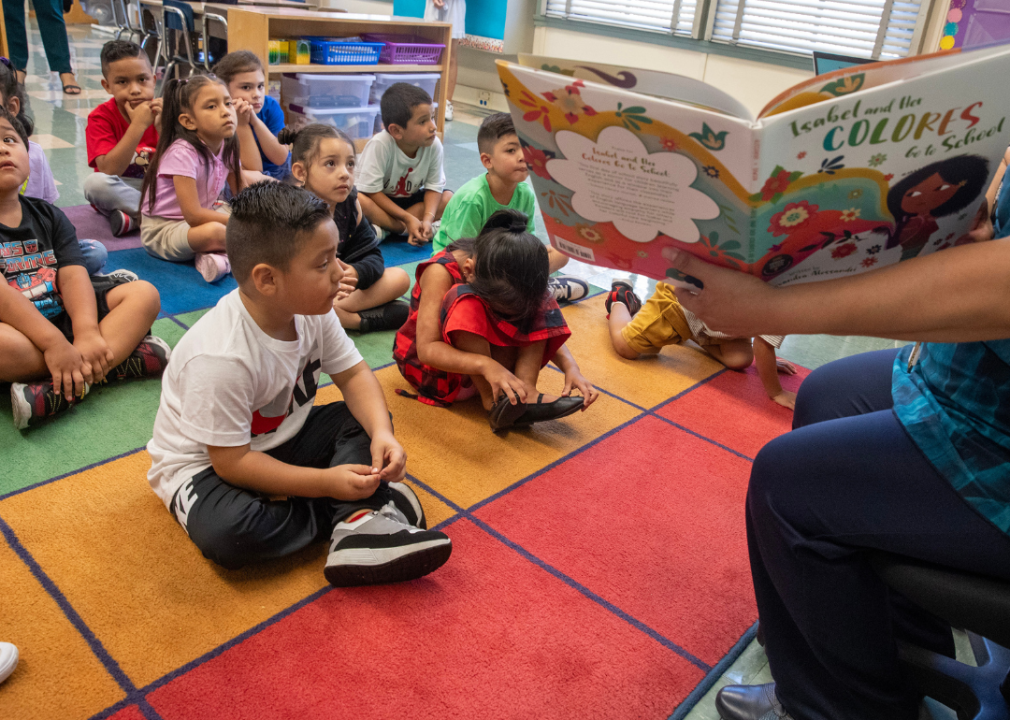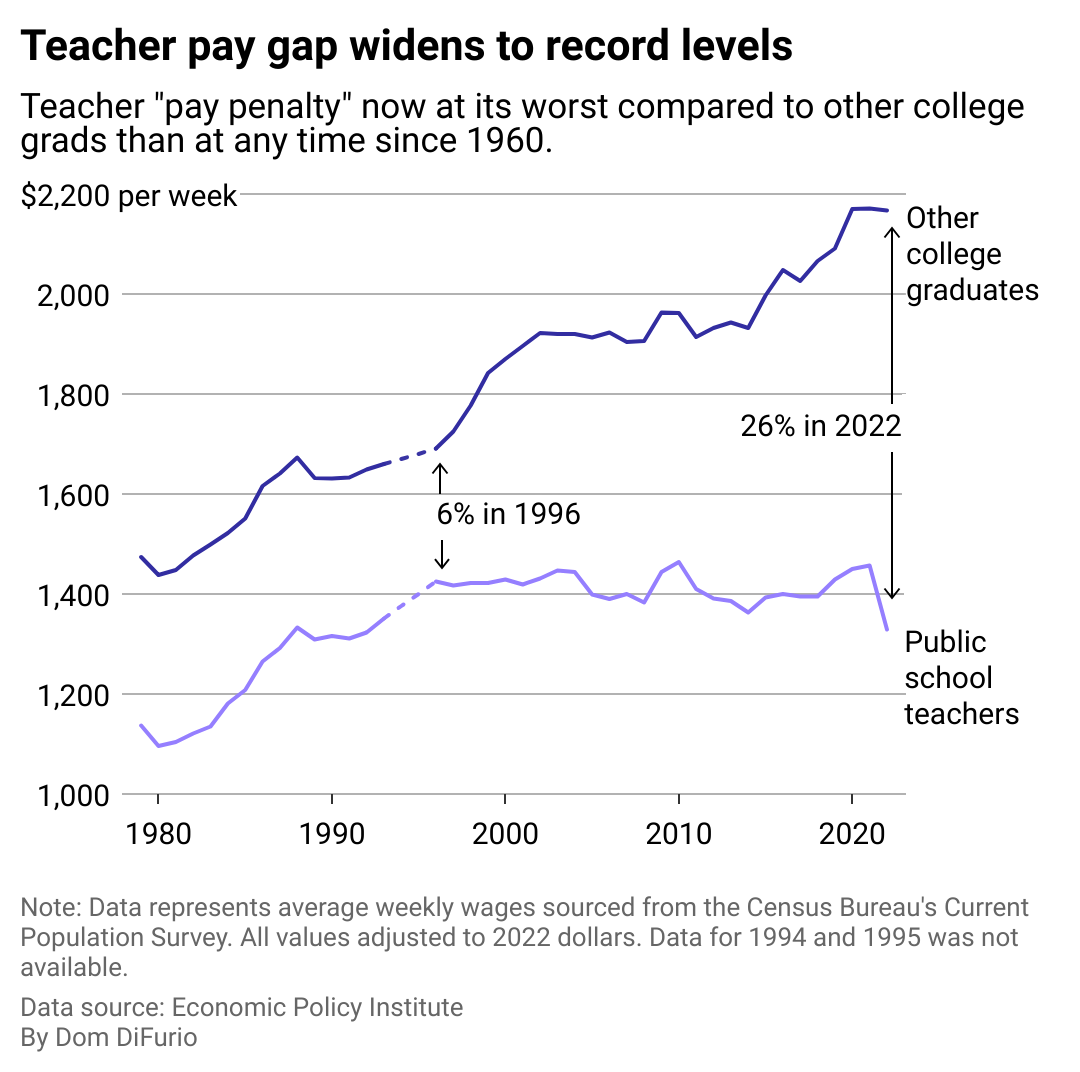The teacher 'pay penalty' is trending in the wrong direction post-pandemic

Brian van der Brug / Los Angeles Times // Getty Images
The teacher ‘pay penalty’ is trending in the wrong direction post-pandemic
A teacher reading to small children in a classroom.
Teaching vacancies continue to plague public schools after the COVID-19 pandemic as modestly paying careers in education, often pursued for their fulfilling nature, are growing even less financially feasible for teachers nationwide.
HeyTutor analyzed data from the Economic Policy Institute to illustrate the compensation teachers forgo when pursuing a career in education and the role of stagnant pay in the ongoing teacher shortage.
More teachers were dissatisfied with their jobs than workers overall, and pay was the least satisfying part of being in the profession, according to a 2024 Pew Research Center survey of public school K-12 teachers nationwide.
Teachers’ growing job frustration may be affecting school districts’ ability to attract and retain the next generation of teachers as existing educators resign or retire. Despite a yearslong teaching shortage, the situation has gotten worse post-pandemic. There are considerably fewer incoming teachers, according to the steady decline in enrollment for teaching degrees since the 2008-09 school year. In at least eight states, teacher turnover rates have reached their highest point in five years.
The shortage comes when retaining qualified teaching staff is extremely important. Teachers are tasked with helping students compensate for the learning loss incurred over the 2020-21 and 2021-22 academic years disrupted by the pandemic. However, nearly half (45%) of public school leaders reported their schools needing more staffing in recent years, according to a National Center for Education Statistics survey. And two-thirds of public school principals said it’s due to a lack of qualified candidates.
Unlike other industries, like nursing, where a worker shortage tends to drive up pay to attract new entrants, increased teacher demand hasn’t boosted pay. Instead, the gap between what teachers earn and all other jobs that require a college education is widening: The average teacher made $1,329 a week in 2022, about a quarter less than other college graduates who earned $2,167 per week on average.
As of 2022, the gap has more than quadrupled in roughly the last three decades. That’s according to a recent EPI analysis of Census and Bureau of Labor Statistics data, which shows the so-called “pay penalty” among teachers has widened to its most extreme since 1960.
![]()

HeyTutor
For teachers, a broadening gulf between peer degree holders
A dual-line chart showing the average weekly earnings of public school teachers and other college grads from 1980-2022. The lines diverge over time, representing 6% lower average earning for public school teachers in 1996, and a 26% lower average in 2022.
The pay disparity between teaching professionals and other professionals holding college degrees has diverged even more dramatically in recent decades. This is because those in the private sector have reaped the benefits of rising wages in the recovery period after the Great Recession and the subsequent hot pandemic labor market.
A National Education Association report published last year found that teacher pay has failed to keep up with inflation, let alone be commensurate with other professions. The analysis from the NEA, the largest labor union representing educators in the U.S., found that teachers’ inflation-adjusted earnings are 5% less on average compared with 10 years ago.
Because teaching has been a profession dominated by women, pay was low from the get-go. In the 1960s, it was one of the limited jobs available to women, according to the EPI. Opportunities for women to earn more in other industries have grown, but teaching has remained the same. Per data from the Census Bureau’s Current Population Survey, professional opportunities for women have grown as college-educated women now outnumber college-educated men. In many states, the sense of fulfillment from a teaching job comes at the expense of an income that doesn’t always cover living expenses.
The inability of legislators to pass laws that would provide more funding for public education has meant schools have had to do more and more with fewer resources. And today, public schools that have benefitted from COVID-19 stimulus are now facing potentially painful cuts to spending as federal pandemic aid runs out this summer.
Still, there are signs that the teacher shortage may be improving. The latest NCES survey of school leaders shows an eight-percentage-point improvement in understaffing. For now, some states are requesting retired teachers return to the classroom full-time to help fill thousands of vacant positions, a short-term fix for an issue that could impact our economy for decades.
Story editing by Alizah Salario. Additional editing by Kelly Glass. Copy editing by Janina Lawrence. Photo selection by Lacy Kerrick.
This story originally appeared on HeyTutor and was produced and
distributed in partnership with Stacker Studio.